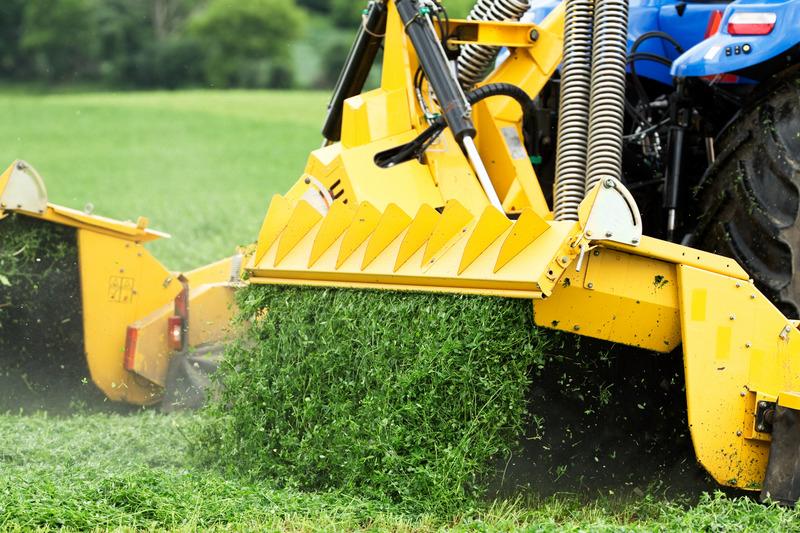
Pasture and Forage Minute: Planting Forage in Stubble and Seeding Year Alfalfa Management
Controlling Yucca on Rangeland
Yucca plants, which are also called soapweed, can be quite common on rangeland in western and central Nebraska. They are especially noticeable here in June when flowering. In some areas, they can be quite thick and significantly reduce grass production. There are ways, though, to reclaim those grazinglands.
Once established, yucca plants can increase on drier rangeland sites. They produce a deep taproot that competes aggressively for the limited water in these soils. With sharp leaves protecting the plant, cattle rarely eat it during summer. Grass production decreases while yucca thrives.
Herbicides like Remedy Ultra®; PastureGard HL®; Pathfinder II®, Tordon®, Velpar, or Cimarron Plus® can control yucca, but only when each individual plant is sprayed directly. Hexazinone products like Velpar L®; Pronone Power Pellet, or Velossa® be applied to the soil uphill side of individual yucca plants with exact delivery hand-gun applicator, since pasture grass streaking injury downslope can occur with chemical movement. General broadcast spraying to control yucca on rangeland is cost prohibitive, although small patches can and should be controlled before they expand. Herbicides are most effective when applied in spring or summer. When using herbicides, be sure to follow label directions for the best control.
Some people have had some success in reducing yucca through winter grazing. During winter, yucca often is the only green plant around. Sometimes cows actually will get down on their knees, lay their head sideways on the ground, and chew through the base of the plant to get to the moist, tender parts. It has been observed, though, that it can take some time for animals to learn to graze yucca and there may be some animals in the herd that will not graze it while others can be quite proficient. After several consecutive winters of grazing, yucca stands can be reduced so grass again thrives during summer.
Whether it is with herbicides or trying some winter grazing, this might be a good year to reclaim some of your pasture back from yucca.
Seeding Forage into Stubble
Wheat and rye stubble can be an excellent seedbed to plant forages using no-till if moisture is available. Despite drought lowering small grain yields, recent rains may provide opportunity for those needing additional forage this year with summer annuals seeding.
Moisture will be the key to successfully seed forages into stubble. Remember that bright wheat straw can reflect heat and increase surface evaporation. Therefore, drill the forage seeds while surface moisture is available and establish forage canopy as soon as possible following grain harvest to lower soil surface temperatures and transfer moisture into the new plants.
Spotty stands often result from topsoil drying out rapidly after wheat has been combined. Surface soil drying may not be as critical if irrigation is available but dry soils can wreak havoc on rainfed stand establishment. Where adequate rainfall has occurred, seed germinating moisture may still be present near the soil surface during the combine harvest.
Again, planting without delay following field harvest increases probability for summer annual forage establishment success. The most popular summer annual forages used in Nebraska include forage sorghums like Mega Green and Pacesetter, sorghum-sudangrass like 1st Choice BMR, sudangrass and hybrid sudangrass. Pearl millet and foxtail millet offer good drought tolerance and reduced prussic acid but these forages also have less tonnage production potential. Overall, no-till planting of forage cover crops and summer annual forages can conserve soil moisture, reduce erosion, suppress weed growth and lower tillage expenses.
Managing Seeding Year Alfalfa
Alfalfa seeded this spring is ready, or soon will be ready, to cut. Proper care and management now could have big impacts on cuttings later this year. Use the following harvest guidelines to get the most from your first-year alfalfa.
Seeding year alfalfa is different from established stands. Stems are spindly, roots are small and shorter, and growth is a little slower.
You can harvest seeding year alfalfa as early as 40 days after seedlings emerge. Again, this is 40 days after emergence, not planting. Alfalfa takes about 40 days to develop the ability to regrow from the crown after cutting. Plants cut before this point need at least one set of leaves remaining to regrow. So, if you need to cut early for something like weed or insect control, cut high.
Although alfalfa seedlings can be harvested 40 days after emerging, I think it’s better to wait until around 60 days after emergence, at late bud to early bloom stage, before the first cutting. Yield will be a little higher and plants will withstand weather stress easier with a little extra growth. This extra time also allows increased root development, helping avoid problems from soil compaction or surface soil dryness.
After the first cutting, regrowth of seedling alfalfa will become more similar to established alfalfa, giving you the opportunity for two or three cuts the first year.
One last point — while it may seem like a long way off, never cut seeding year alfalfa during the four-week period before a killing freeze. Winter injury can be severe due to reduced winterhardiness of new plants. Look ahead at the calendar now to plan when future cuts might be taken to avoid cutting during this sensitive time.
First year alfalfa can be productive, just manage it right.
Online Master of Science in Agronomy
With a focus on industry applications and research, the online program is designed with maximum flexibility for today's working professionals.
